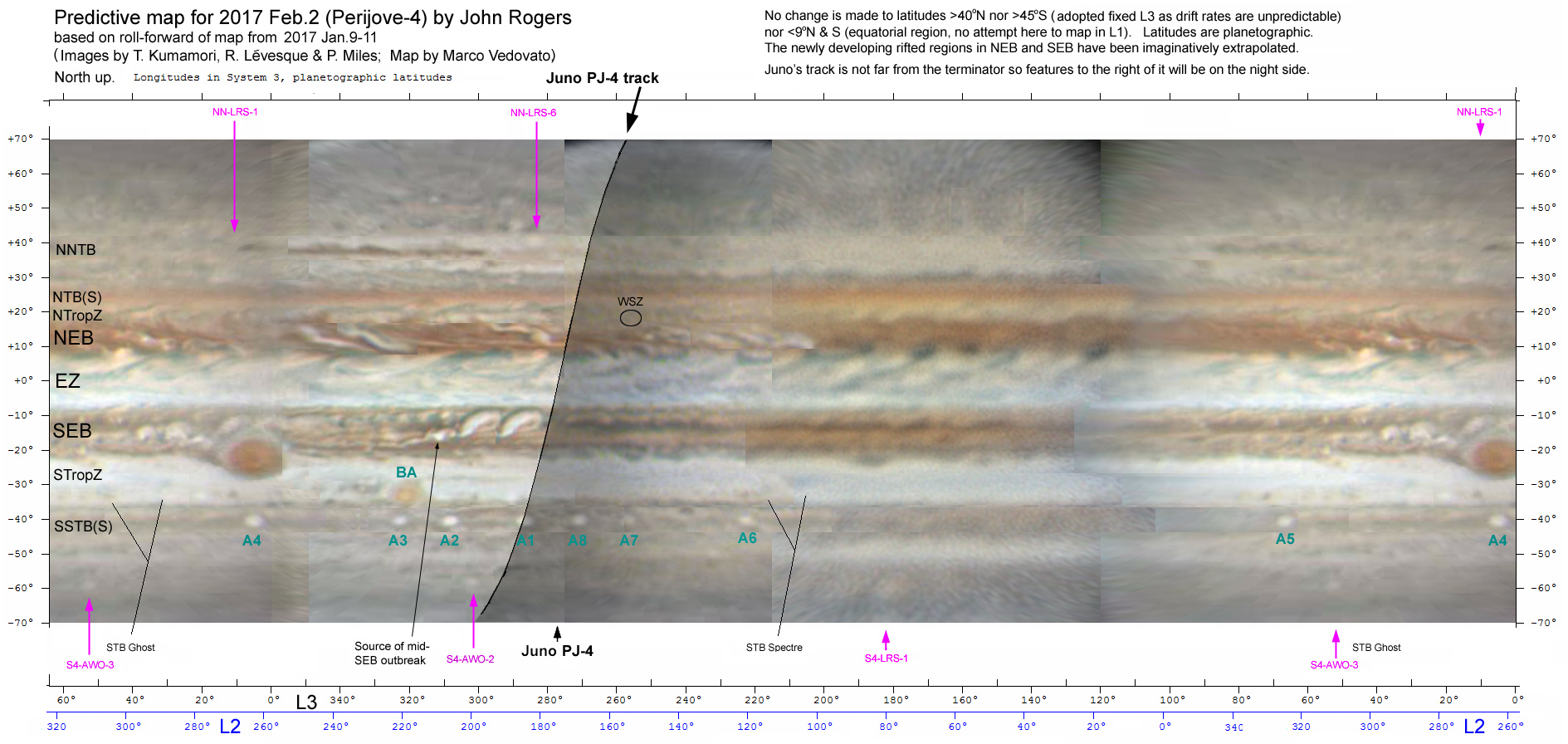2016-17, Report no.5: Preview of Juno’s Perijove-4
Juno’s Perijove-4 will be on 2017 Feb.2. Attached is a predictive map, showing how I expect the planet to look, and what will be visible to JunoCam.
By good fortune, Jupiter is providing a wealth of worthwhile targets to choose from at this flyby. While Jupiter produced a rare outbreak in the NTB before PJ-2, and a new NEB outbreak before PJ-3, now it has produced a new SEB outbreak before PJ-4; and all of these will be in the viewing track at PJ-4.
To determine which targets will be imaged, everyone is invited to vote (from Jan.19-23) at: https://www.missionjuno.swri.edu/junocam
So please go there and vote for your favoured 3 ‘Points of Interest’ (POIs)! Voting has opened on Jan.19.0, and I have revised the following suggestions in the light of the POIs offered on the web site. The targetting is by latitude [please see note below.*] For suggestions 2, 3 & 5 below, there are several POIs at similar latitude; I hope the JunoCam team will sort it out if votes are split among them.
I would like to recommend the following in order of priority.
1) The NTB(S) – the new orange belt. [POI: ‘The Big Red Stripe v2’: latitude +22.7 centric.] The NTB is presently in upheaval from the great outbreak spotted by Juno prior to PJ-2. It is developing rapidly so this is a unique opportunity. At PJ-3, JunoCam got a fine image of the new orange belt and adjacent turbulence. Let’s repeat the PJ-3 image and see how it has changed (Latitude +22.7 centric, +25.5 graphic).
2) The disrupted NEB north edge. [POI: ‘White Spot Z’ (lat. +14.3 c)] These latitudes are currently very disrupted from both the NTBs upheaval and new outbreaks of white ‘rifts’ (convective storms) in the NEB. Although white spot Z itself may be out of view, the whole region is interesting: Can JunoCam show how where the turbulence is spreading from? For direct comparison, it will be best to repeat the PJ-3 image (Latitude +15.1 centric, +17.1 graphic). [POI: ‘Dark spot in turbulence’ is at the same latitude.]
3) The new mid-SEB outbreak. [POI: ‘Structure01’ (lat. -13.75 c)] This is a dramatic outbreak of white ‘rifts’ (convective storms) which appeared on Dec.29 and is now spreading through the SEB. Another unique opportunity to catch an exciting phenomenon! [POI: ‘Outbreak!’ (lat. -11.8 c) is also part of it but a ‘Structure01’ image will capture more of it.]
4) Oval BA and currents east of it. [POI: ‘Oval BA’ (lat. -32.7 c)] The great red oval BA itself may be too far from Juno’s track, but Juno will get a good view of the region east of it which has tended to produce new circulations in recent years. How do these arise?—perhaps a closeup image will give some clues.
5) SS-AWOs [3 POIs: ‘String of pearls’]. The anticyclonic white ovals of the S.S. Temperate domain. Beautiful circulations; ovals A1 and/or A2 will be on display this time. [There are 3 POIs: I will vote for the one on the right.]
6) NN-LRS-6 [POI: ‘Small white storm’(lat. +36.25 c)] – a Little Red Spot in the NNTZ, formerly White Spot 6. A beautiful oval, but it will look very like NN-LRS-1 which was perfectly imaged at PJ-3.
7) NEB rifts. [POI: ‘Band transition’ (+13.4 c)] There is a lot of rift activity in this region, but it will be covered by target (2), so there is no need to vote for another POI nearby.
*[Latitudes: Two systems are used, planetocentric and planetographic; in the JunoCam Planning map and in the text above the latitudes of POIs are given as ‘centric, as indicated by ‘c’ above. For several POIs, it would be best take images at exactly the same latitudes as at PJ-3, otherwise the extreme perspective will make it more difficult to compare the images.]
–John Rogers, 2017 Jan.18.

| The British Astronomical Association supports amateur astronomers around the UK and the rest of the world. Find out more about the BAA or join us. |
